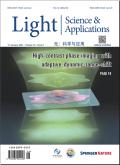Optical neural networks: progress and challenges.
IF 20.6
Q1 OPTICS
引用次数: 0
Abstract
Artificial intelligence has prevailed in all trades and professions due to the assistance of big data resources, advanced algorithms, and high-performance electronic hardware. However, conventional computing hardware is inefficient at implementing complex tasks, in large part because the memory and processor in its computing architecture are separated, performing insufficiently in computing speed and energy consumption. In recent years, optical neural networks (ONNs) have made a range of research progress in optical computing due to advantages such as sub-nanosecond latency, low heat dissipation, and high parallelism. ONNs are in prospect to provide support regarding computing speed and energy consumption for the further development of artificial intelligence with a novel computing paradigm. Herein, we first introduce the design method and principle of ONNs based on various optical elements. Then, we successively review the non-integrated ONNs consisting of volume optical components and the integrated ONNs composed of on-chip components. Finally, we summarize and discuss the computational density, nonlinearity, scalability, and practical applications of ONNs, and comment on the challenges and perspectives of the ONNs in the future development trends.光学神经网络:进展与挑战。
在大数据资源、先进算法和高性能电子硬件的帮助下,人工智能在各行各业大行其道。然而,传统计算硬件在执行复杂任务时效率低下,很大程度上是因为其计算架构中的内存和处理器是分离的,在运算速度和能耗方面表现不足。近年来,光神经网络(ONNs)凭借亚纳秒级延迟、低散热和高并行性等优势,在光计算领域取得了一系列研究进展。ONNs有望在计算速度和能源消耗方面为人工智能的进一步发展提供支持,成为一种新的计算模式。在此,我们首先介绍了基于各种光学元件的 ONN 的设计方法和原理。然后,我们依次回顾了由体积光学元件组成的非集成 ONN 和由片上元件组成的集成 ONN。最后,我们总结并讨论了 ONNs 的计算密度、非线性、可扩展性和实际应用,并对 ONNs 在未来发展趋势中面临的挑战和前景进行了评论。
本文章由计算机程序翻译,如有差异,请以英文原文为准。
求助全文
约1分钟内获得全文
求助全文
来源期刊

Light-Science & Applications
数理科学, 物理学I, 光学, 凝聚态物性 II :电子结构、电学、磁学和光学性质, 无机非金属材料, 无机非金属类光电信息与功能材料, 工程与材料, 信息科学, 光学和光电子学, 光学和光电子材料, 非线性光学与量子光学
自引率
0.00%
发文量
803
审稿时长
2.1 months
 求助内容:
求助内容: 应助结果提醒方式:
应助结果提醒方式:


